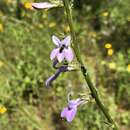Comprehensive Description
provided by North American Flora
Lobelia glandulosa Walt. Fl. Car. 218. 1788
Lobelia crassiuscula Michx. Fl. Bor. Am. 2: 152. 1803.
Lobelia puberula var. glabella Ell. Bot. S. C. & Ga. 1: 267. 1817. (Type from Chatham County,
Georgia.) Rapunlium glandulosum Presl, Prodr. Mon. Lob. 21. 1836. Dortmannia glandulosa Kuntze, Rev. Gen. 972. 1891.
Stem unbranched, weak, sometimes zigzag, erect or ascending, usually less than 2 mm. in diameter at base, 30-140 cm. long (often tall, 90-100 cm.), glabrous, green, or darker below; leaves cauline, few-20, glabrous, thick, narrowly linear to broadly lanceolate, 0.2-1.4 cm. wide by 3-15 cm. long (averaging about 0.6 cm. wnde by 8 cm. long), usually about 15 times as long as wide, decurrent, not much narrowed at the base e.xcept the lowest, somewhat appressed to the stem, strongly callose-denticulate or subentire in outline, the upper ones merging into the floral bracts, but the larger leaves well below the inflorescence; inflorescence usually strongly secund, 15 cm. long or less, bearing 1-20 (averaging 8-10) rather widely spaced flowers; pedicels stout, rough-puberulent or hirsute, straight, upright, 5-13 mm. long in fruit, each with a pair of bracteoles near the base; flower-bracts glabrous, Unear, rarely much exceeding the pedicels, usually strongly callose-denticulate; flower 20-33 mm. long, including hypanthium (averaging 24-25 mm.); corolla blue with a white eye, glabrous or pubescent without, hirsute within at the base of the lower lip, the tube 9-12 mm. long, fenestrate, the lobes of the lower lip oblong or ovate, sometimes acute, about the length of the tube, sometimes as large as S mm. wide by 16 nun. long, the two upper lobes narrow -ovate, curved upward; filament-tube 7.5-10 mm. long (usually 8.5-9 mm.), the filaments pubescent near base, connate more than half their length; anther-tube 3.5-4 mm. long, light bluish-gray, all five anthers tufted, or the three larger merely pubescent on the backs; h-panthium in anthesis short-hemispheric or flatter, glabrous, puberulent or long chaffy-hirsute, becoming hemispheric or subglobose in fruit, 6-8 mm. in diameter; capsule more than three-fourths inferior, 6-8 mm. long, often slightly broader than long; calyx-lobes narrow, almost linear, or broader (long-lanceolate or wedge-shaped), glabrous, acute, 3-15 mm. long, usually strongly callose-denticulate, sometimes entire; auricles none, or small and triangular; seeds oblong, about 0.8 mm. long.
Type locality: South Carolina, probably in upper Berkeley County near the Santee River, Waller (Brit. Mus.!).
Distribution: Coastal Plain, southern Virginia to the Florida Keys and west to the Apalachicola River.
- bibliographic citation
- Rogers McVaugh. 1943. CAMPANULALES; CAMPANULACEAE; LOBELIOIDEAE. North American flora. vol 32A(1). New York Botanical Garden, New York, NY

